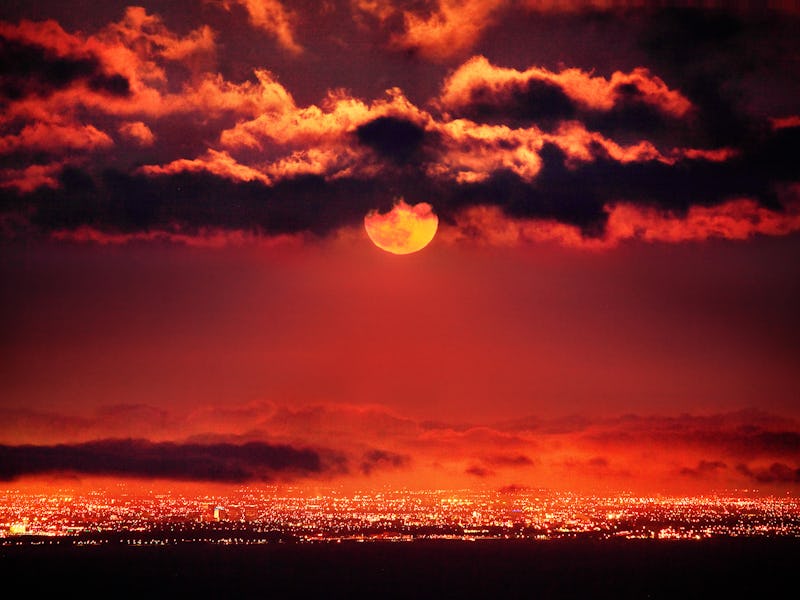How to See the Ultra-Rare Strawberry Moon During Tonight's Summer Solstice
For the first time since 1967, the night of the Solstice will feature a full moon, the Strawberry Moon.

For those of us north of the equator, summer is here. The Summer Solstice, the day signaling our transition from spring to summer, falls on June 20 this year. For our contemporaries to the southern hemisphere, it’s almost winter, too bad for them — same solstice, different outcomes.
On June 20, the sun will rise somewhere around 5:25 a.m. Eastern time and set around 8:40 p.m. That’s 15 total hours of daylight, almost too much time to sit outside and bask in all the waves of Vitamin D pouring down. In contrast, the shortest day of 2016 will be on December 21 and provide only a tad over nine hours of daylight start to finish, and that’s with Daylight Savings.
During the June Solstice, or Summer Solstice, the angle of our planet on its axis puts the Northern hemisphere directly in-line with the light and energy from the Sun. This means that though we are furthest from our star in our elliptical orbit around it, the increased exposure to its light makes for the warmest months. During this time, our days are longer and our nights are shorter, and all of us are pretty happy about it.
Length of daylight on the Summer Solstice
In the far north, places like Alaska, portions of Canada, Norway, and Siberia, really anywhere above or around the 41st parallel, this is the time of year of the Midnight Sun, the Sun that never sets. The 24-hour sunlight the far northerners enjoy could last anywhere from one day to a couple of months. The closer one gets to the pole, the longer the Midnight Sun lasts.
The Latin breakdown for the word solstice is “sol” for “sun” and “sistere” for “to stand still.” June Solstices always fall on June 20, 21, or 22, shifting a day or so because of the fact the Gregorian Calendar is anything but perfect. On the days leading up to and after the solstice, the sun is directly above the Tropic of Cancer at the 23rd parallel. The result is that in the northern hemisphere, it ceases the daily northward progress of its noontime position. It rises from the east to peak at almost the same spot each day, pauses for a bit, then goes straight to the West to set.
Our elliptical orbit..
As an added bonus this year, and for the first time since 1948 (although it was very close in 1967), the night of the Solstice will feature a full moon, the Strawberry Moon. During the day, the sun’s path is the highest and longest it’ll get all year. Conversely, the moon’s trajectory on the 20th is opposite that path, skimming the horizon throughout the night. This will force the light bouncing off the moon and into our eyes to be filtered through the humid air clinging near ground-level and cause our nearest celestial neighbor to take on an amber glow. It will be a true Honey Moon.
You can catch this moon either on Sunday or Monday night and it’ll be awe-inspiring viewed with the naked eye, but obviously more inspirational to look at through a telescope. If you’re interested in a guided tour of the rare event, tune into Slooh’s live feed 6:30 p.m. Eastern time the night of June 20.
Even without cool full moons, solstices have been days of celebration throughout history, and mark an important transition from the growth of the spring season to the approaching dog-days of heat and humidity that accompany summer. Many cultures across the globe have celebrated this day with festivals and ceremonies of harvest.
Currently, the most famous ceremony is held at Stonehenge. Each year tens of thousands of people flock to the prehistoric landmark in England to watch the solstice Sun rise over the heel stone, though no one’s really figured out if that’s really what it’s there for, people seem to enjoy it.
Revelers watch the Solstice Sun rise over Stonehenge Heel Stone
Another cool and unusual solstice tradition, is the Alaskan Fairbanks Goldpanners’ Midnight Baseball Game. Fairbanks, AK sits far enough North to be within the boundaries of the Midnight Sun, and the Solstice game starts at 10:30 p.m. to run well past midnight. The first game was played in 1906, the Goldpanners have hosted it since the ‘60s, no game played has ever used artificial light.
For those who don’t have the opportunity to travel to the British Isles or the last American frontier, we suggest putting on your own celebration. Unfold the lawn chair early in the morning out in your front yard or on your stoop. Put a Bluetooth speaker in the window with this dope Fresh Prince track on a loop, then, spend the day flagging down every ice cream truck you see. Be sure to ask for a different treat each time. If the trucks come by once an hour, you could rack up at least 15 different flavors of Good Humor.